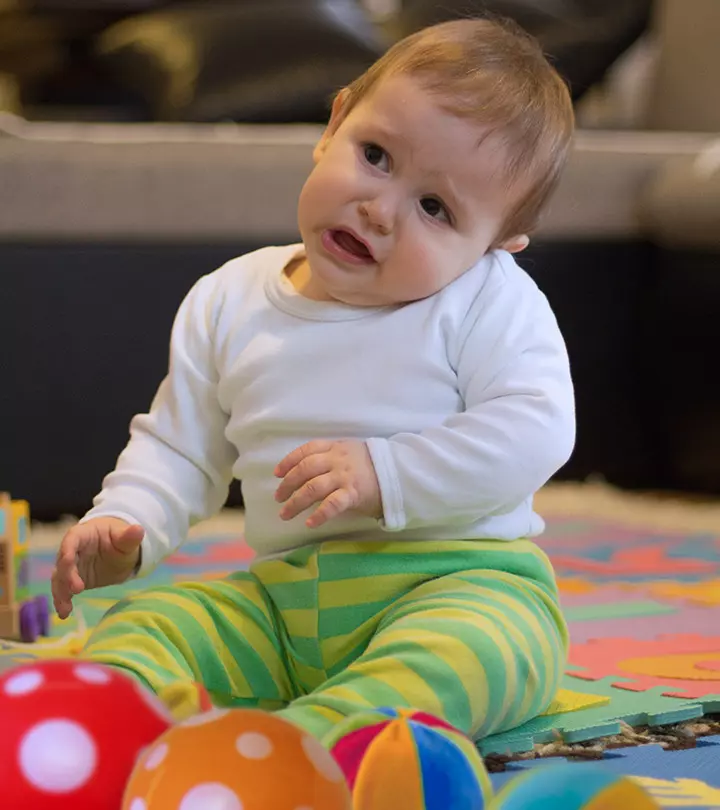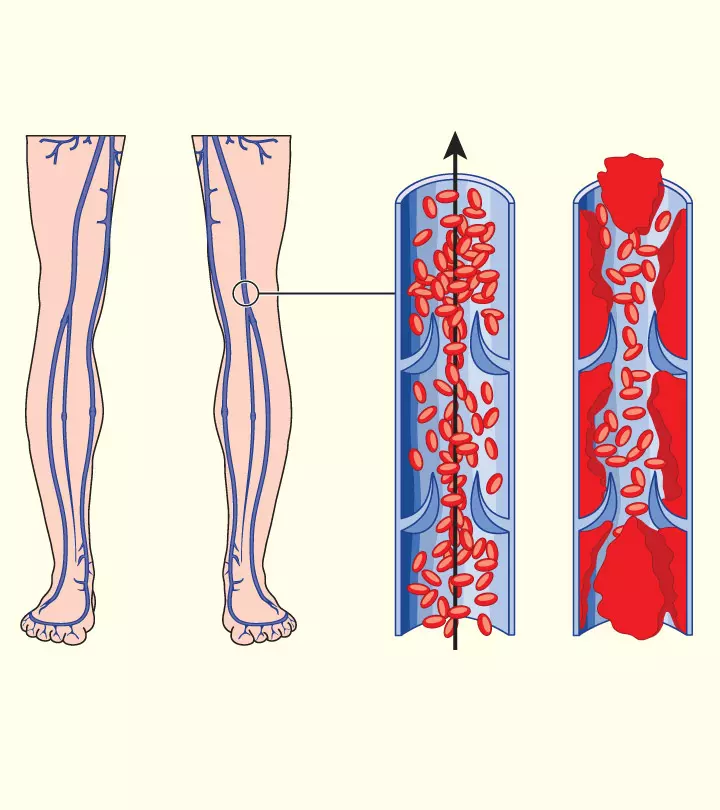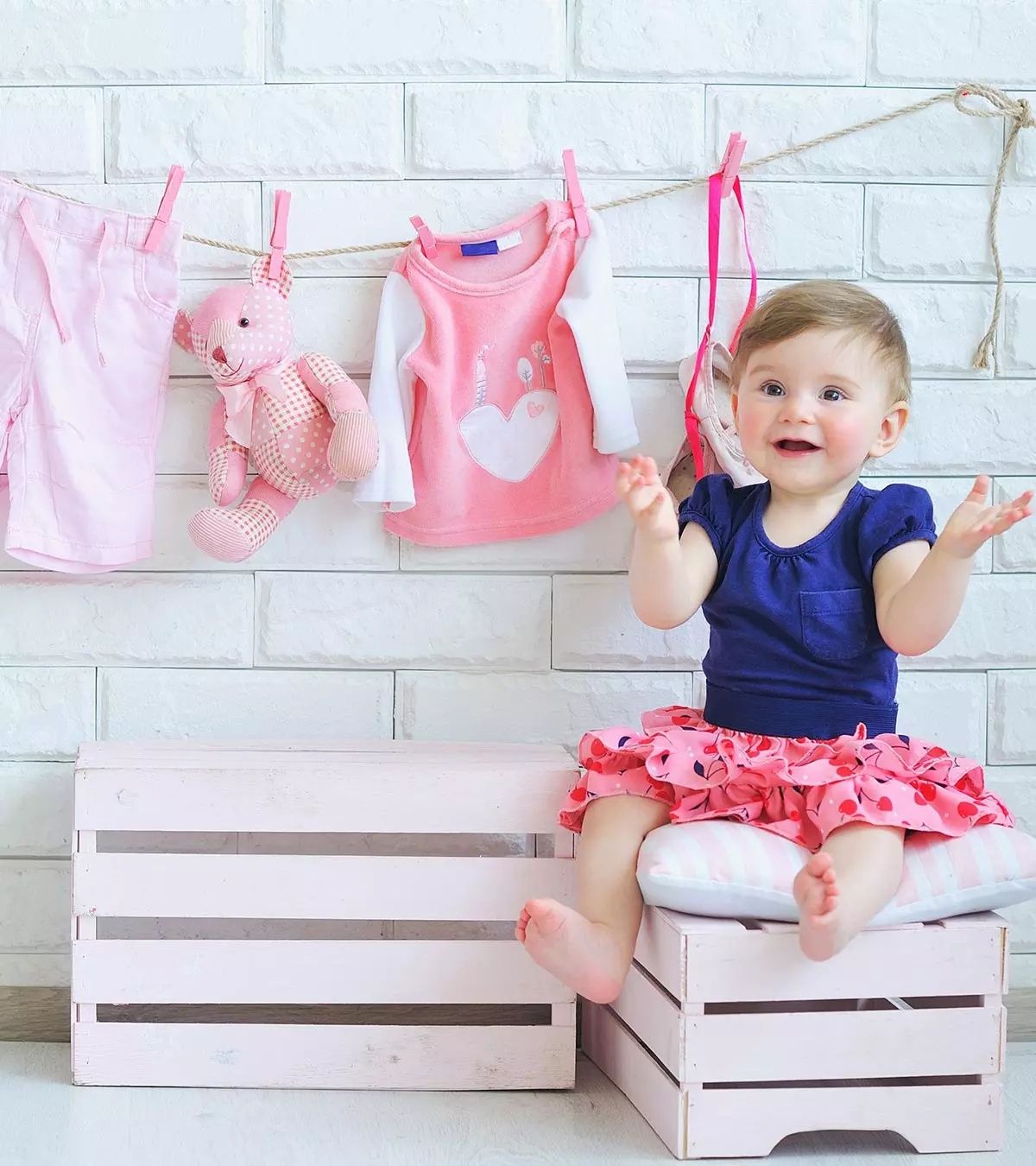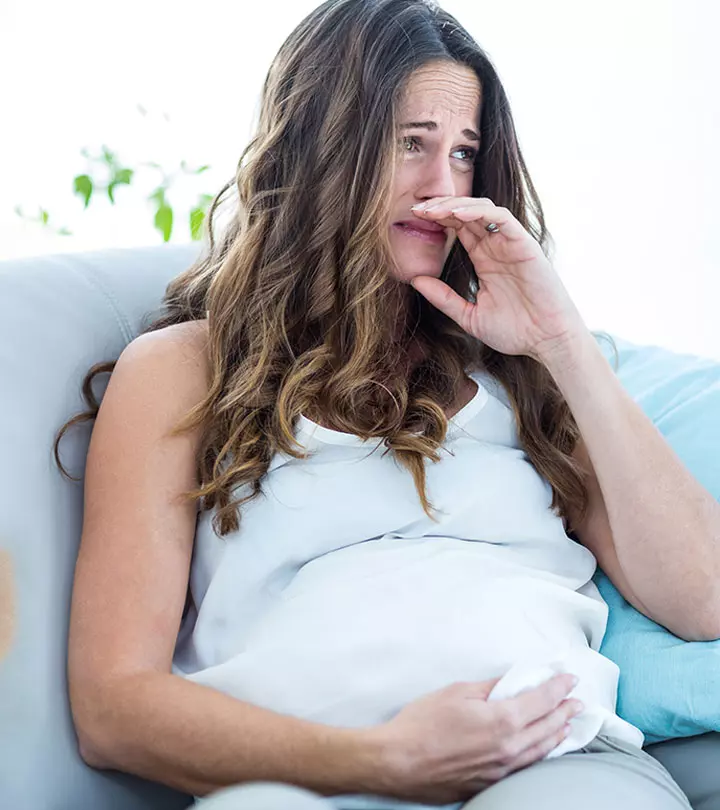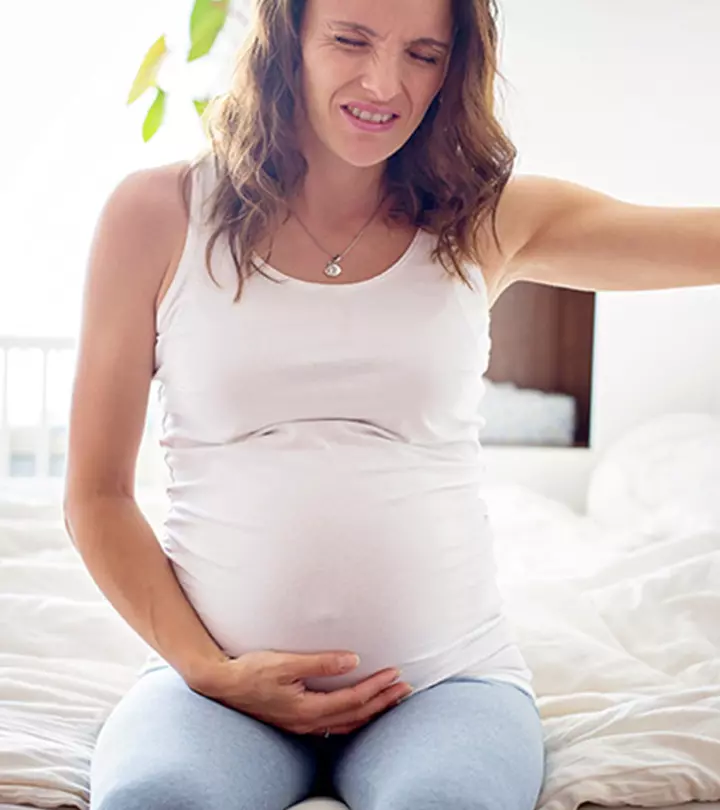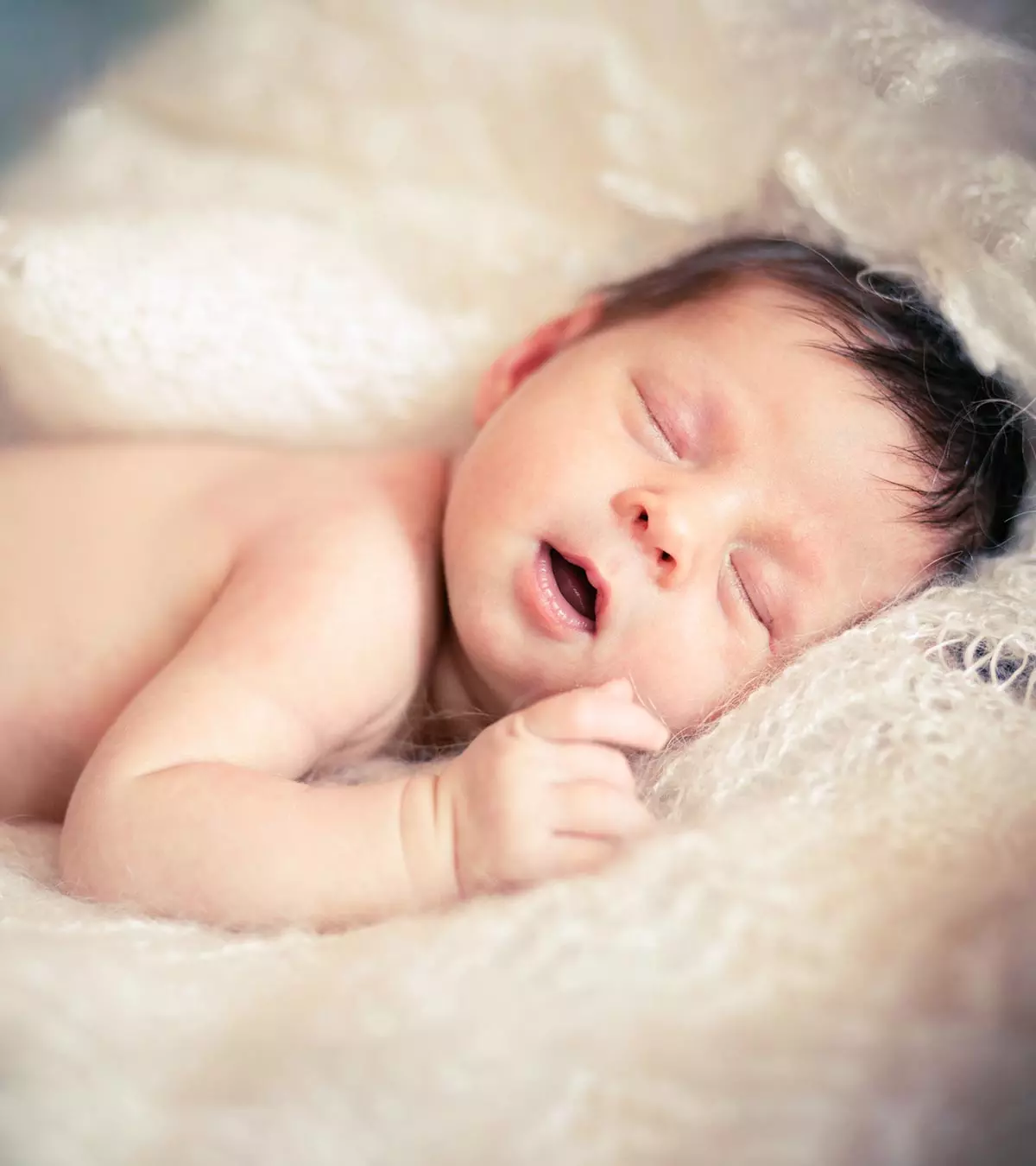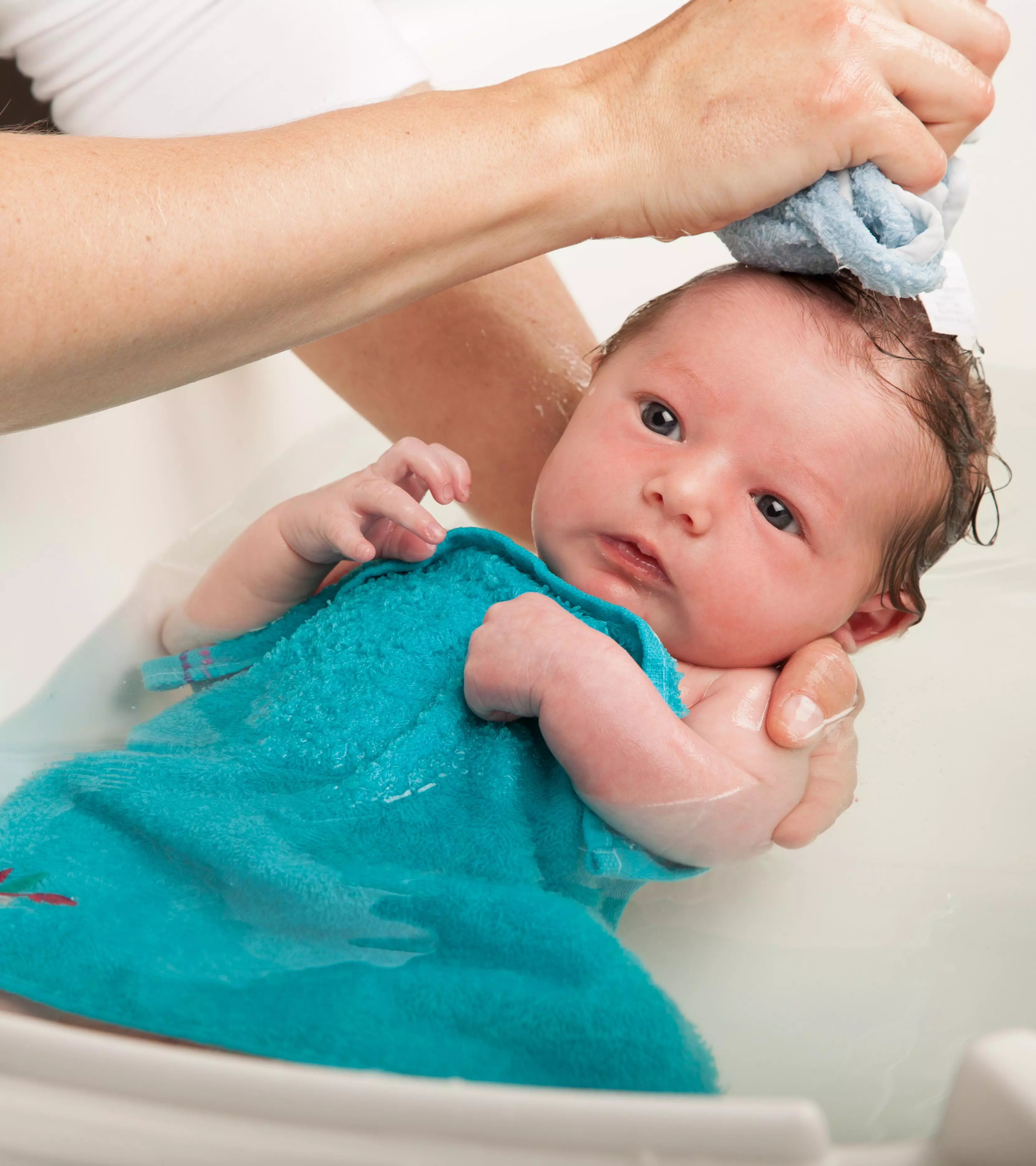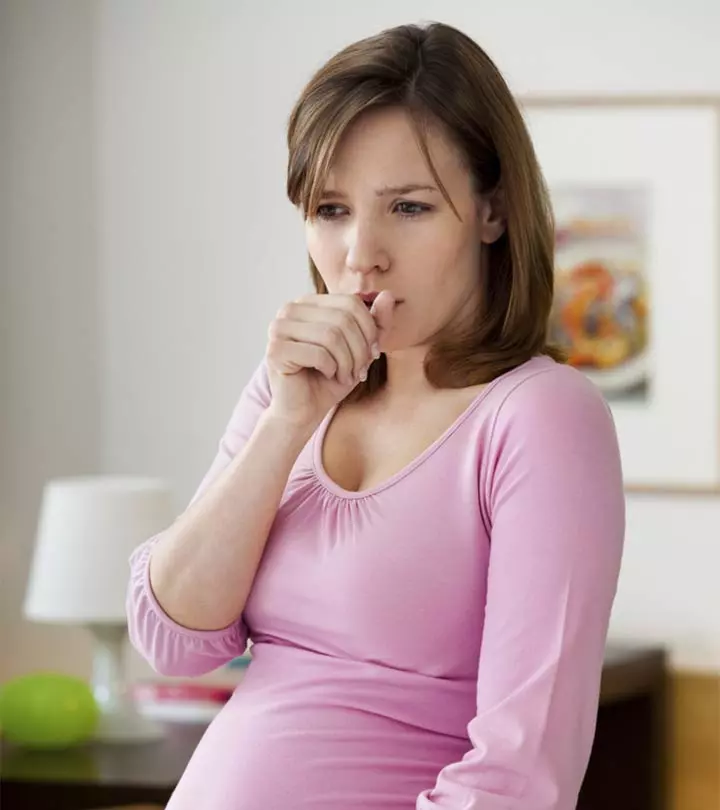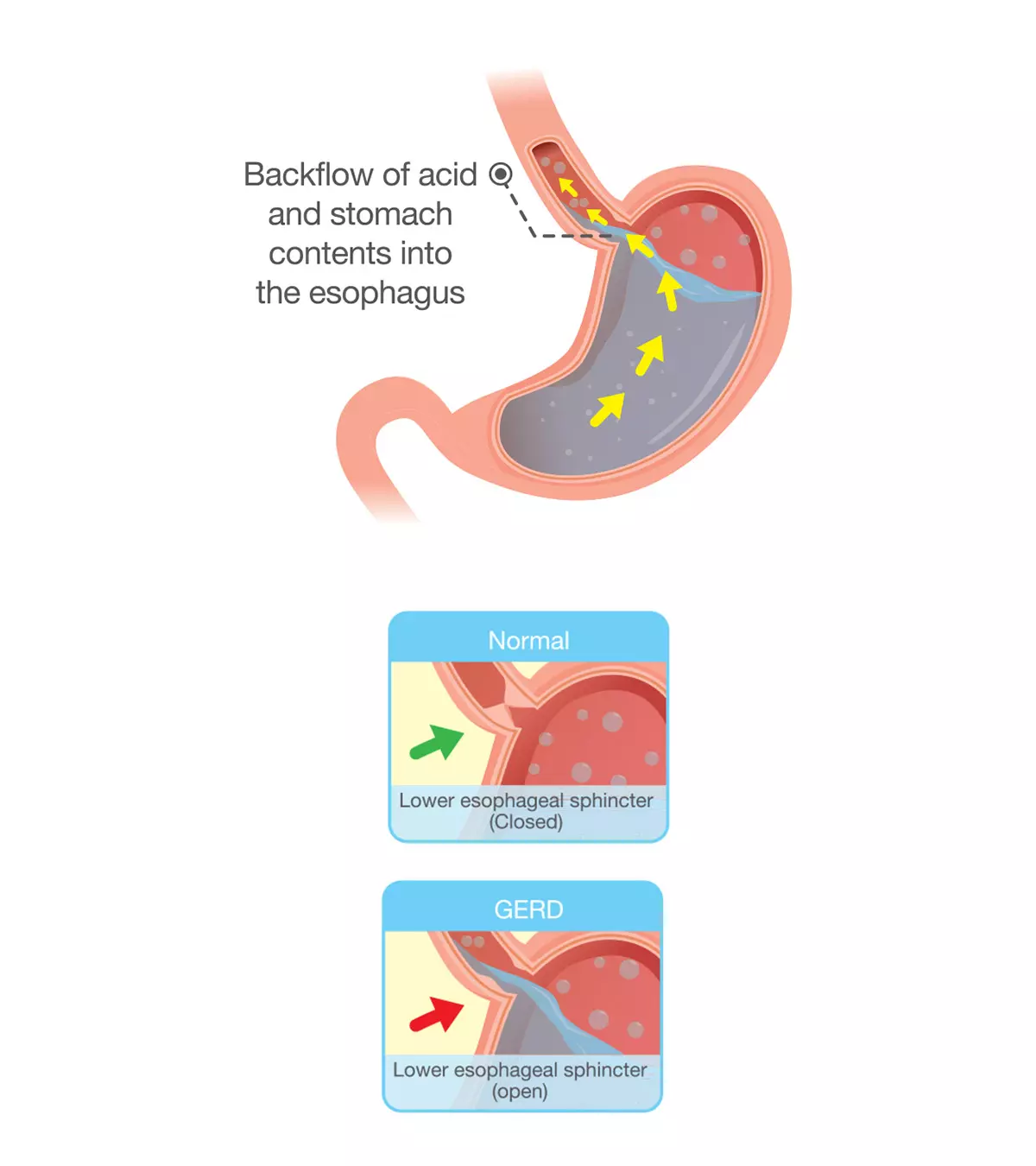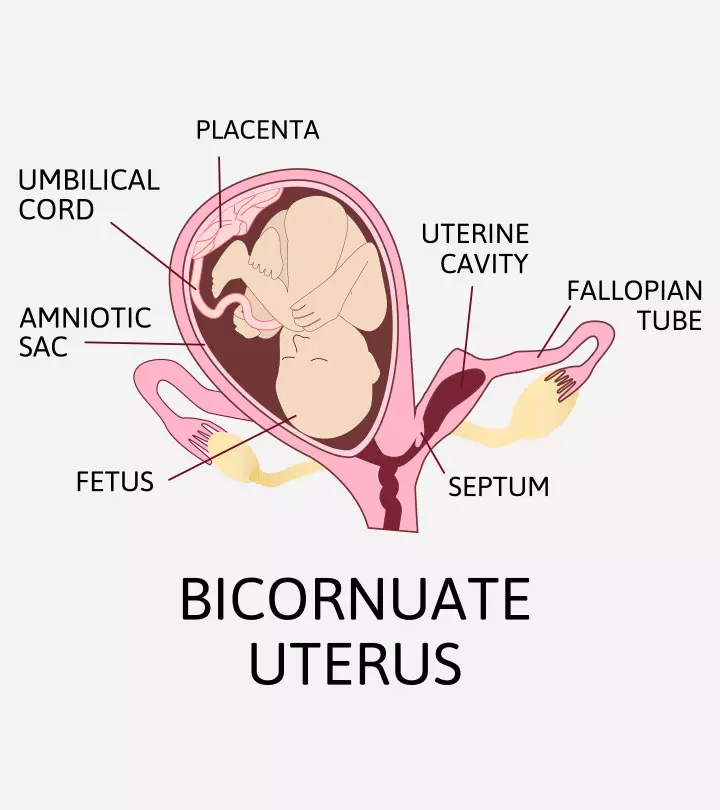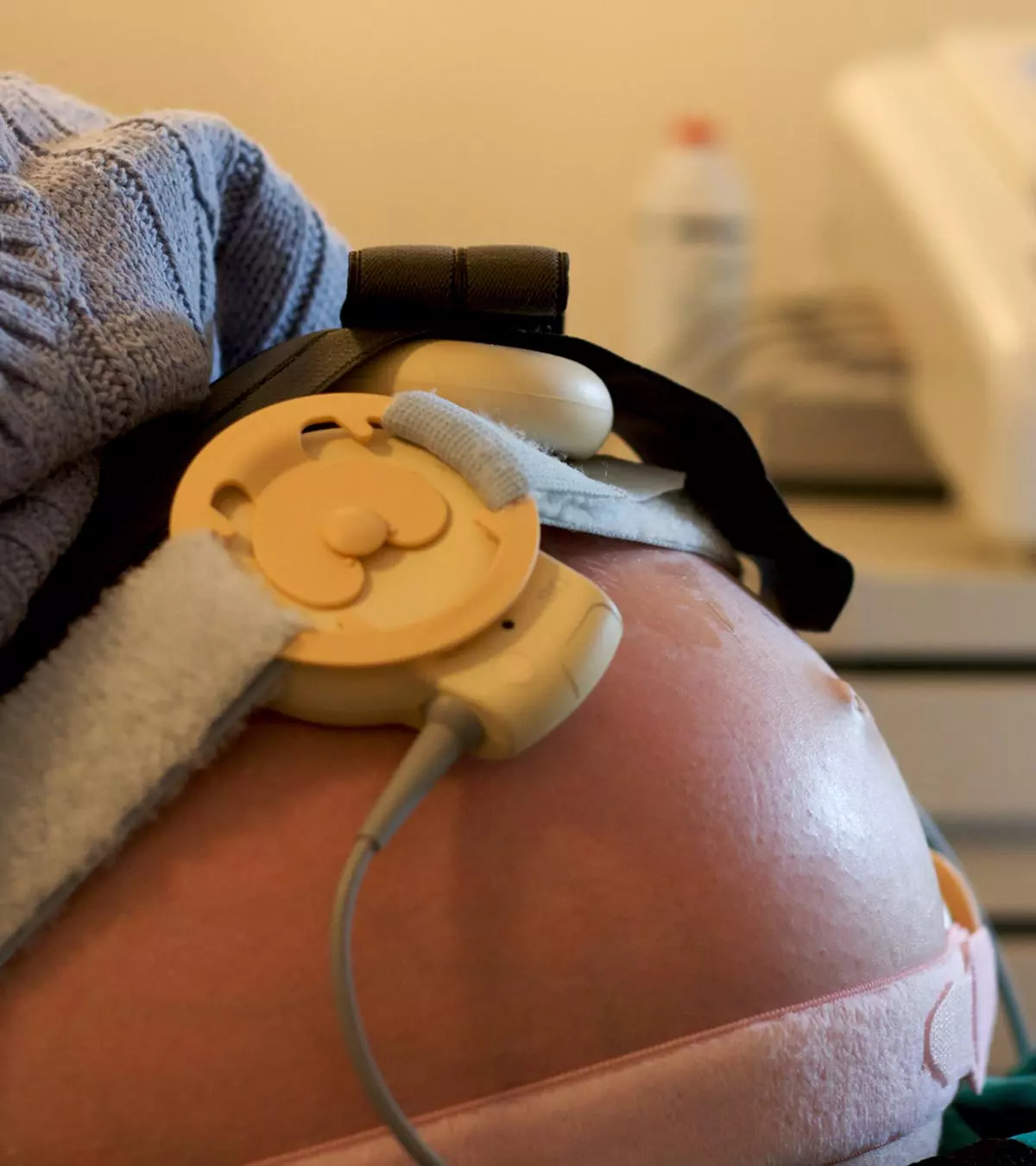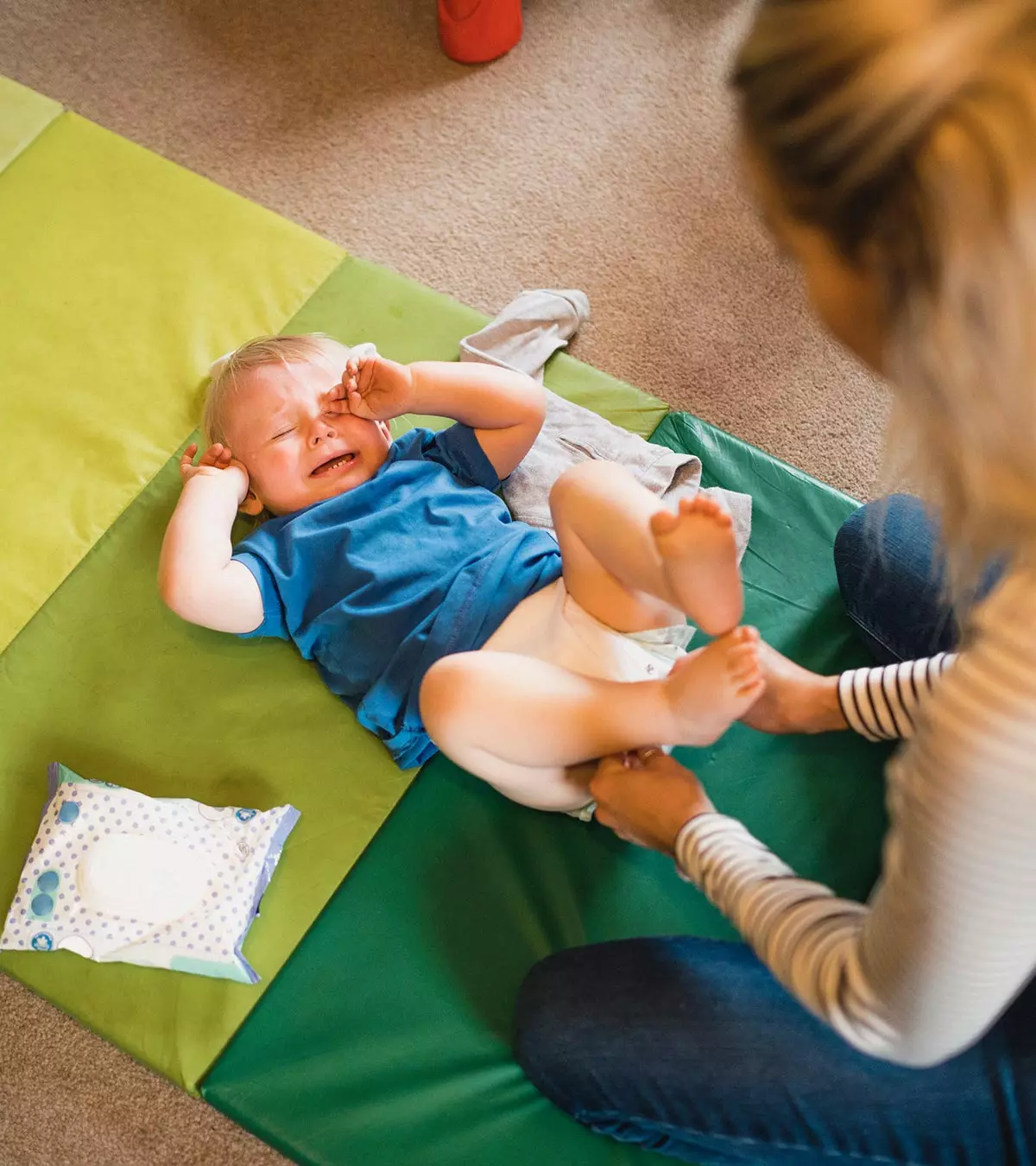
Hemorrhoids in babies are rare, and you may look for symptoms to identify this since babies cannot communicate what is going on in their bodies. Swollen lumps around the anus, crying during bowel movement, and bleeding may indicate hemorrhoids (1). Many babies with hemorrhoids may have a history of constipation and dry stools. Medical and home remedies may help to relieve pain. You may try to avoid constipation in babies by ensuring adequate feeding and a balanced diet. Read on to know the causes, symptoms, and treatment for hemorrhoids in babies.
Key Pointers
- Hemorrhoids are the soft tissue surrounding the anus on the inside and a little on the outside (or piles).
- Hemorrhoids in newborns can occur due to constipation or diarrhea straining the rectal tissue.
- You may notice blood spots in the baby’s diapers and feces, along with irritation and redness around the anus.
- A change in your baby’s diet, hemorrhoid creams, and warm water bath can provide symptomatic relief from hemorrhoids.
- Proper potty training, immediate treatment of constipation and diarrhea, and eating a balanced diet can prevent hemorrhoids in babies.
What Are Hemorrhoids?
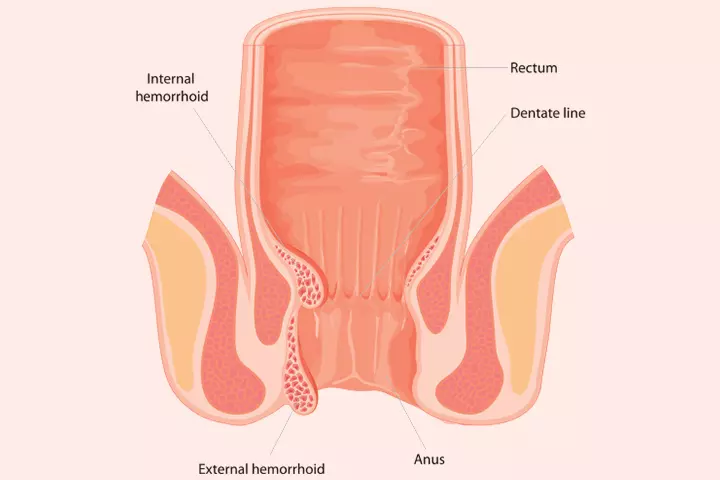
Commonly known as piles, this is a condition where the tissues and blood vessels along the anal opening become swollen (2). The term ’hemorrhoids’ is actually used for the soft tissue that lines the anus on the inside and slightly on the outside. Typically, hemorrhoids work as a cushion (3). But when they swell, they tend to protrude and cause pain and constant anal discomfort.
The term ‘hemorrhoids’ is also used colloquially to refer to the inflamed state of the tissue. Infants also have hemorrhoid tissue, which can swell sometimes.
What Causes Hemorrhoids In Babies?
The primary cause of hemorrhoids is repeated strain on the blood vessels and tissues of the rectal area (4). Frequent pressure on the blood vessels leads to inflammation and eventually piles, which affects the baby’s health. Here are a few reasons why a baby may strain the rectal tissue (1) (5) (6):
- Constipation: Constipation leads to repeated straining of the tissue for the release of feces. It is by far the most common cause of hemorrhoids.
- Diarrhea: It causes the infant to pass stool repeatedly. The frequent excretion of stools can exert the hemorrhoids tissue.
- Low fiber diet and poor hydration (in the case of toddlers): Fiber and water are vital for the smooth passage of stools. Low fiber and water intake can harden the stools, which require more pressure to pass.
- Improper toilet training: Toddlers with incorrect advice on potty training may sit on a toilet and strain hard to excrete. Repeated strain can give rise to perianal conditions, such as piles, even without constipation or diarrhea.
- Genetic anomalies: Some babies may develop hemorrhoids due to anomalies in their gastrointestinal tract. Those with a family history of the condition can be more prone to it.
- Liver malfunction: When the liver doesn’t work correctly, blood that should flow through it gets blocked or slowed down. This forces the blood to find other ways to travel, often through smaller blood vessels around the rectum and anus. The increased blood volume and pressure in these vessels can cause them to swell and form internal hemorrhoids. This condition is called portal hypertension. This unusual blood flow pattern is a sign of a serious liver problem in babies as it indicates that the liver is not functioning well.
 Quick fact
Quick factConstipation and diarrhea are likely to be the two most common situations a baby may face. But how frequently can they develop hemorrhoids?
How Common Are Hemorrhoids In Babies?
Hemorrhoids are rare among babies and toddlers (7). The occurrence of hemorrhoids in children is extremely rare, and in most cases, a different underlying cause is identified. The risk of piles becomes significant when the baby turns into a teen and a young adult (8).
If your baby is constantly crying when seated or rested on the bottom or while passing the stool, then it is good to check for the symptoms of hemorrhoids.
What Are The Symptoms Of Hemorrhoids?
Parents will notice the following symptoms when a baby or a toddler has hemorrhoids (9) (10) (11):
- Blood spots in the diaper and the stool: It is going to be the first tell-tale sign. It is a good practice to check what came out in the diaper before disposing of it. Swollen veins of hemorrhoids can leak blood, which will find its way out with the feces. Blood in baby’s stool or diapers can indicate that the baby has piles. The chances of this are higher if the baby already has constipation.
- Redness, bleeding, and inflammation at the anus: If there is blood in stools and the diaper, check the baby’s anal opening. Hemorrhoids are visible from the outside as inflammation or as a hard lump around the anus, along with redness. Hemorrhoids can appear blue or purple when filled with blood. However, when they are not engorged with blood, they may resemble loose folds of skin. Severe cases will also cause small quantities of blood to accumulate around the anus.
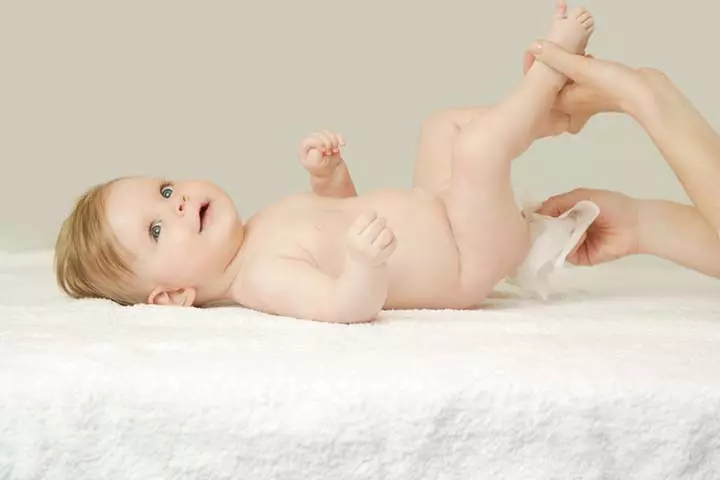
- Itching and irritation: Hemorrhoids cause anal itching and discomfort in the lower pelvic region. A baby with hemorrhoids will repeatedly try touching their bottom. Older toddlers may frequently scratch their bottom and may even complain of discomfort around their anus.
 Did you know?
Did you know?It is good to see a doctor soon when you spot blood in a baby’s diapers or stools. Also seek medical attention (10):
- If you notice black or tarry stools.
- Your baby is constipated and it doesn’t get better even with treatment.
- Your baby has a swollen vein near the anus (hemorrhoid) that doesn’t go away after a bowel movement.
- The bleeding doesn’t stop.
How Are Hemorrhoids Diagnosed?

Pediatric doctors can diagnose hemorrhoids in babies and toddlers by visual inspection of the anal region. If the hemorrhoids are internal and not discernible, then a physical exam may be needed.
The doctor will gently palpate the area around the anus with their gloved fingers and check for any signs of internal hemorrhoid bleeding (12).
Other diagnostic methods such as anoscopy and proctoscopy (using a probe to inspect anus and rectum respectively) are highly unlikely to be used for infants and toddlers. These methods may be used when the bleeding is from parts of the gastrointestinal tract other than the anus. Your baby’s pediatrician may also take a thorough medical history to learn about any underlying condition causing hemorrhoids.
How Are Hemorrhoids Treated In Babies?
The hemorrhoids may be treated using medicines, home remedies, and lifestyle changes (1) (13) (14):
- Treatment of the chronic cause: The first step will be to cure the underlying reason for piles. So if the baby has constipation or diarrhea, then the doctor will treat these conditions. Once the problem is remedied, wait for a few days to let the inflammation come down on its own.
- Warm water baths: Warm water baths can soothe the anal irritation caused by hemorrhoids. Let the baby soak in lukewarm water for about 10 minutes, twice a day. The warm water relaxes the hemorrhoid tissue and the inflamed blood vessels, thus soothing the irritation. Baths, in general, are quite soothing for infants and will help them feel better.
- Changes in diet: Provide more water and fiber-rich foods such as whole grains, carrots, broccoli, apples, and oranges to the toddler.
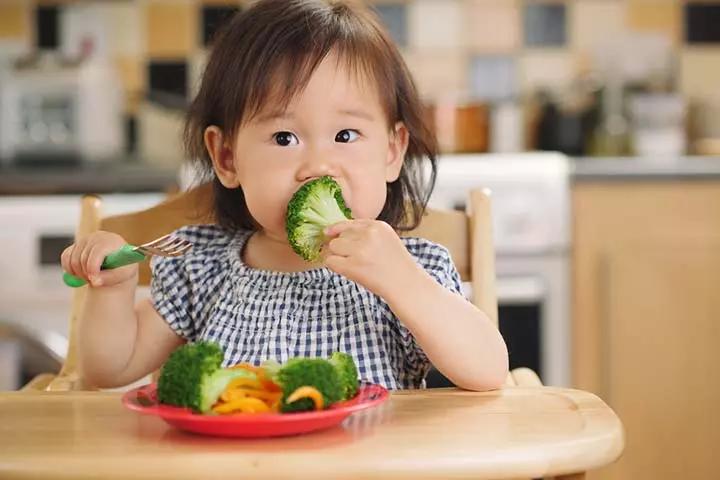
- Hemorrhoids creams: These creams relieve the itching of the anal region. Use the cream only as prescribed by the doctor. It has to be used for a limited period and is needed only when the baby suffers from intense itching.
Pediatrician Dr. Bidisha Sarkar says, “Topical medication can help reduce the swelling and pain of hemorrhoids. However, it is not recommended for babies, as it may cause skin irritation, allergic reactions, or interfere with the healing process of the delicate anal tissue. Hemorrhoid cream is also not approved by the Food and Drug Administration (FDA) for use in children under 12 years old.”
 Quick tip
Quick tipCuring the underlying cause of the problem should help in curing the hemorrhoids. That said, you can also try a few home care measures to prevent the condition and spare the baby from the pain.
How To Prevent Hemorrhoids?
The following three measures can help mitigate a baby and toddler’s chances of developing hemorrhoids (1) (16):
- Check for constipation and diarrhea: Be alert to the first signs of constipation and diarrhea since these problems can lead to piles when left unchecked. Diarrhea results in frequent and watery stools, while constipation causes the baby’s poop to become hard and lumpy. Acting fast on treating them will minimize the risk of developing hemorrhoids and maintain proper anal hygiene.
- Correct potty practice: Tell the toddler not to strain to poop. Also, do not force them to finish pooping in a stipulated time. Let them sit on the potty chair or toilet and wait until they naturally feel the urge to relieve themselves. This potty practice can prevent straining and inflammation of hemorrhoids in toddlers. The potty should be appropriate size for them or a foot stool can be used if the toilet is being used. The knees should ideally be higher than the hips.
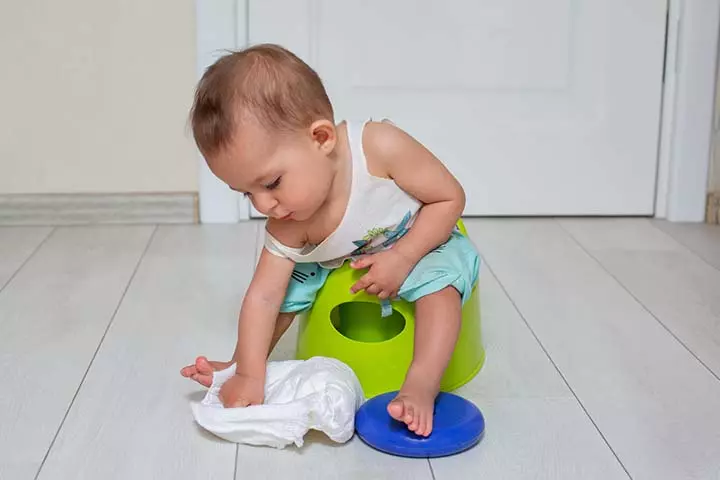
- Balanced diet: Give the toddler the right mix of solid food, which includes high fiber food items. Get them to drink enough water so that they are always hydrated. Eating high-fiber foods and adequate hydration decreases the chances of constipation in babies, which is a common cause of hemorrhoids.
Frequently Asked Questions
1. What other conditions can be mistaken as hemorrhoids in babies?
Anal fissures, anal warts, rectal polyps, and skin tags (acrochordons) are some conditions that are often mistaken as hemorrhoids in babies or newborns (1).
2. What do toddler hemorrhoids look like?
Toddler hemorrhoids look like small reddish or bluish bumps near the edge of the anus. Usually, hemorrhoids appear blue or purple when they are full of blood. But when they aren’t full of blood, the skin appears loose (1) (10).
3. Are hemorrhoids cancerous?
Dr. Sarkar says, “Hemorrhoids are not cancerous. They are benign (noncancerous) growths of swollen veins in the rectum and anus. Hemorrhoids are usually caused by increased pressure in the veins around the anus due to factors such as constipation, straining during bowel movements.”
4. Are hemorrhoids genetic?
According to Dr. Sarkar, “Hemorrhoids are not directly inherited from parents, but they may have some genetic factors that increase the risk. For example, some babies may have weaker connective tissue in their anal walls, which makes them more prone to stretching and swelling under pressure.”
5. Is surgery ever required to treat hemorrhoids in babies?
Hemorrhoids in babies can be treated without surgery and by implementing specific dietary changes, maintaining good cleanliness practices, and using prescribed topical treatments. However, in severe and persistent cases, a doctor may advise surgical intervention as a last resort (1).
Constipation, diarrhea, low fiber diet, and inappropriate toilet training are common causes of hemorrhoids in babies. These problems can strain the rectal tissue during bowel movements and result in hemorrhoid formation. Since they cannot communicate their discomfort, learn to identify the signs of hemorrhoids in babies, such as bleeding, rectal swelling, redness, or blood spots on diapers. Pediatricians can diagnose hemorrhoids through physical examination and treat the underlying cause to relieve discomfort. Warm water baths, creams, dietary modifications, and changes in potty practices are recommended to improve the condition.
Infographic: How To Understand That Your Baby Has Hemorrhoids?
Blood on your baby’s diapers can be alarming. However, there can be several reasons for anal bleeding, and a closer inspection may be required. The infographic below highlights the identifying features of hemorrhoids in babies, helping you distinguish them from other similar conditions. Illustration: Momjunction Design Team
Illustration: Hemorrhoids In Babies: Causes Symptoms And Treatment

Image: Dall·E/MomJunction Design Team
References
- Hemorrhoids in Babies.
https://my.clevelandclinic.org/health/symptoms/22626-hemorrhoids-in-babies - Hemorrhoids.
https://fascrs.org/patients/diseases-and-conditions/a-z/hemorrhoids - Overview: Enlarged hemorrhoids.
https://www.ncbi.nlm.nih.gov/books/NBK279467/ - Hemorrhoids.
https://www.hopkinsmedicine.org/health/conditions-and-diseases/hemorrhoids - Hemorrhoids.
https://www.niddk.nih.gov/health-information/digestive-diseases/hemorrhoids - Portal Hypertension.
https://www.vascularcures.org/portal-hypertension - N D Heaton et.al; (1992); Symptomatic hemorrhoids and anorectal varices in children with portal hypertension.
https://pubmed.ncbi.nlm.nih.gov/1640328/ - Ramin Jamshidi; (2018); Anorectal Complaints: Hemorrhoids, Fissures, Abscesses, Fistulae.
https://pmc.ncbi.nlm.nih.gov/articles/PMC5825861/#:~:text=As%20constipation%20is%20common%20in,develop%20until%20the%20teenage%20years. - Hemorrhoids.
https://choc.org/programs-services/gastroenterology/hemorrhoids/#symptoms - Hemorrhoids (1761).
https://childrenswi.org/publications/teaching-sheet/gi/1761-hemorrhoids - Hemorrhoids.
https://www.connecticutchildrens.org/specialties-conditions/pediatric-surgery/conditions/hemorrhoids - Hemorrhoids.
https://www.cham.org/health-library/article?id=aa66614 - Hemorrhoids and what to do about them.
https://www.health.harvard.edu/diseases-and-conditions/hemorrhoids_and_what_to_do_about_them - 6 self-help tips for hemorrhoid flare-ups.
https://www.health.harvard.edu/blog/6-self-help-tips-for-hemorrhoid-flare-ups-201307196496 - Constipation in Infants.
https://www.nationwidechildrens.org/conditions/constipation-infant - Preventing Hemorrhoids.
https://www.georgiahae.com/what-causes-hemorrhoids/prevention/
Community Experiences
Join the conversation and become a part of our nurturing community! Share your stories, experiences, and insights to connect with fellow parents.
Read full bio of Dr. Wayne Hough
- Dr. Bidisha Sarkar is a pediatrician with nine years of experience. She did her graduation in Medicine from NRS Medical College, Kolkata and holds specialization in Pediatrics. Dr. Sarkar currently practices at KIMS Hospital in Hyderabad, India.
 Dr. Bidisha Sarkar is a pediatrician with nine years of experience. She did her graduation in Medicine from NRS Medical College, Kolkata and holds specialization in Pediatrics. Dr. Sarkar currently practices at KIMS Hospital in Hyderabad, India.
Dr. Bidisha Sarkar is a pediatrician with nine years of experience. She did her graduation in Medicine from NRS Medical College, Kolkata and holds specialization in Pediatrics. Dr. Sarkar currently practices at KIMS Hospital in Hyderabad, India.
Read full bio of Rohit Garoo
Read full bio of Dr. Ritika Shah
Read full bio of Vidya Tadapatri





